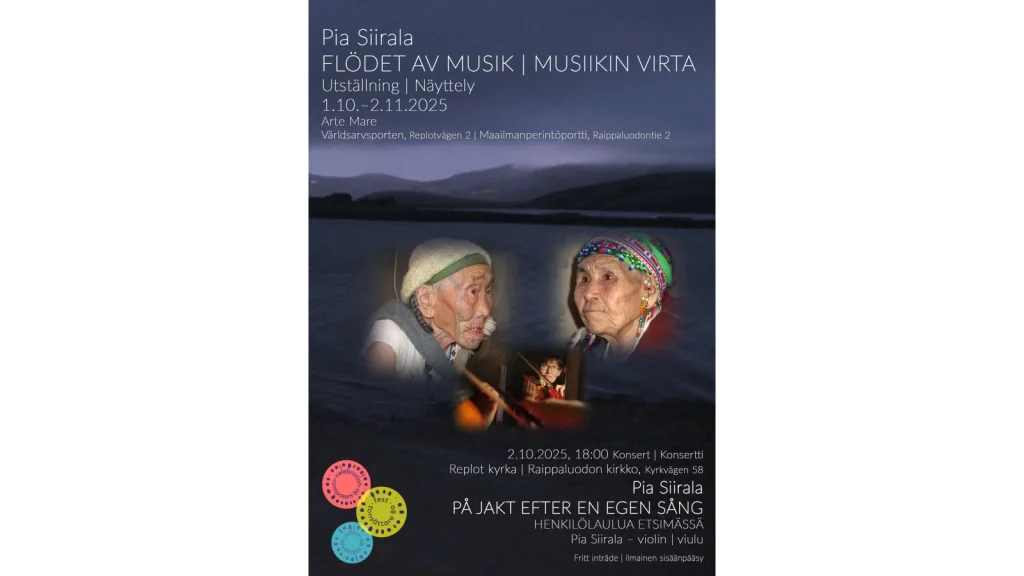
THE FLOW OF MUSIC

Article categories: Museums & Folklore
A multimedia exhibition – a story about fieldtrips to northeastern Siberia, to the lands of the Chukchi
Singers on video: Etilyan, Kuang, Kulyumich and Tingaan
Photographs, Excerpts from the Field Diaries & Video Filming, Editing and Violin Improvisation on video: Pia Siirala
Violin recording & Video sound mixing: Robert de Godzinsky
Picture frames: Matti Kautonen
The Flow of Music multimedia exhibition recounts with pictures, sounds and words, violinist Pia Siirala’s field trips to the lands of the Chukchi in Chukotka and Kamchatka. Between 2004-2019, Siirala made seven field trips to northeastern Siberia, where she became acquainted with the indigenous singing traditions in Sakhalin, Kamchatka and Chukotka, recording about 1400 songs.
The 24 photographs in the Flow of Music exhibition are, for the most part, photographs of the Chukchi singers whom Pia Siirala met during her field trips in northeastern Siberia. The texts, which are excerpts from her field diaries, take on added meaning when accompanied by her photographs. The soundscape of the exhibition space is very specific. In it one can hear the Personal Songs of the singers in the photographs, as well as the sounds of nature and the rhythm of life in the Siberian Arctic nomadic people’s environment.
Exhibition visitors also get a glimpse into the everyday life of four Chukchi Elders in the video filmed by Siirala. The violin improvisation reflects the author’s inner journey into the life and music of these singers.
Siirala explains: I have witnessed situations where a singer becomes wrapped up in their own thoughts and forgets the world around them. When some mundane activity interrupts their singing, the song does not end but rather recedes into the background. Similarly, speech can seamlessly change into singing, or a singer may resume singing in the middle of a conversation.
The frames for the exhibition pictures also have their own significance. The frames are made from dead pine branches collected from rocky forest glades left behind after clear-cutting. The branches are reminiscent of the wood collected by reindeer herders on the tundra, but at the same time they symbolise the destruction of natural forests and the threat to indigenous cultures.
-
Time
1.10.2025 – 2.11.2025 10.00 – 16.00Event times
- 1.10.2025 10.00 – 16.00
- 2.10.2025 10.00 – 16.00
- 3.10.2025 10.00 – 16.00
- 4.10.2025 10.00 – 16.00
- 5.10.2025 10.00 – 16.00
- 6.10.2025 10.00 – 16.00
- 7.10.2025 10.00 – 16.00
- 8.10.2025 10.00 – 16.00
- 9.10.2025 10.00 – 16.00
- 10.10.2025 10.00 – 16.00
- 11.10.2025 10.00 – 16.00
- 12.10.2025 10.00 – 16.00
- 13.10.2025 10.00 – 16.00
- 14.10.2025 10.00 – 16.00
- 15.10.2025 10.00 – 16.00
- 16.10.2025 10.00 – 16.00
- 17.10.2025 10.00 – 16.00
- 18.10.2025 10.00 – 16.00
- 19.10.2025 10.00 – 16.00
- 20.10.2025 10.00 – 16.00
- 21.10.2025 10.00 – 16.00
- 22.10.2025 10.00 – 16.00
- 23.10.2025 10.00 – 16.00
- 24.10.2025 10.00 – 16.00
- 25.10.2025 10.00 – 16.00
- 26.10.2025 10.00 – 16.00
- 27.10.2025 10.00 – 16.00
- 28.10.2025 10.00 – 16.00
- 29.10.2025 10.00 – 16.00
- 30.10.2025 10.00 – 16.00
- 31.10.2025 10.00 – 16.00
- 1.11.2025 10.00 – 16.00
- 2.11.2025 10.00 – 16.00
-
Place
World Heritage Gateway – Arte Mare Raippaluodontie 2, 65800 Raippaluoto Show route on map -
Organizer
Ensemble XXI 0443589034 pia@ensemblexxi.org https://ensemblexxi.org/